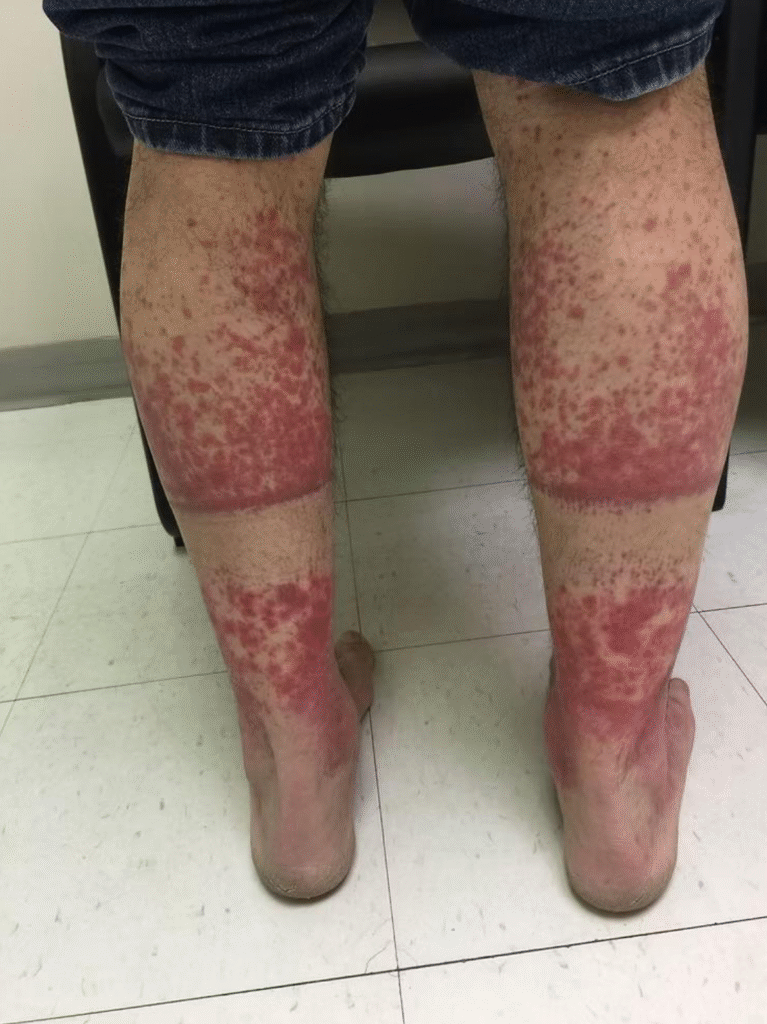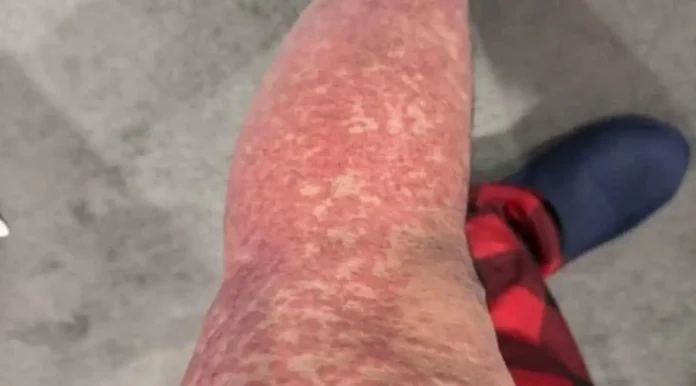At first glance, it might look like nothing more than a curious cosmetic change—a subtle, lace-like web spreading across the skin in shades of blue and purple. But this condition, known as livedo reticularis, goes deeper than just the surface. While it’s temporary and harmless in some instances, in others, it can serve as an early warning sign of a serious, underlying illness.
What Exactly Is This Net-Like Skin Pattern?
Livedo reticularis refers to a net-shaped, reddish-purple discoloration that appears on the skin, most frequently seen on the arms, legs, or torso. This pattern forms when blood flow in the tiny vessels beneath the skin is uneven or pools, creating visible areas where the oxygen supply is reduced.

The distinctive mottling frequently becomes more noticeable when exposed to cold environments and may disappear as the skin gets warmer. This is why many people simply dismiss it as a circulatory peculiarity. Nonetheless, its continued presence can sometimes point toward much more significant health concerns.
Distinguishing The Two Forms
Primary (Physiological) Livedo Reticularis
- Typically benign and triggered primarily by exposure to cold temperatures.
- Most common in children, young adults, and those with lighter skin tones.
- Usually resolves completely once the body is warm again.
- Remains visible regardless of temperature changes.
- Can be an indication of serious medical conditions, including vascular diseases, autoimmune disorders, or issues with blood clotting.
- Requires a thorough medical evaluation and often ongoing management to treat the root cause.
Potential Causes Behind the Pattern
The reasons for the development of livedo reticularis are varied:
- Exposure to Cold: This is the most common and typically non-threatening trigger.
- Vascular Diseases: Conditions that interrupt normal blood flow, such as peripheral artery disease or vasculitis.
- Autoimmune Disorders: Skin changes can be a sign of illnesses like Lupus, rheumatoid arthritis, or antiphospholipid syndrome.
- Blood Clotting Abnormalities: Conditions like thrombophilia or other clotting issues can disrupt circulation patterns.
- Medication Side Effects: Certain drugs used to treat chronic conditions, such as those for high blood pressure or Parkinson’s disease, have been associated with livedo-like patterns.
In more unusual instances, this condition has been linked to severe systemic illnesses like Sneddon’s syndrome (a rare disorder associated with strokes), polyarteritis nodosa, or cholesterol embolization.
Key Symptoms and Warning Signs
The most recognizable symptom is the mottled, web-like pattern on the skin. However, other red flags might accompany it:
- Persistent feeling of coldness or numbness in the affected area.
- Pain, cramping, or a sense of heaviness in the legs.
- Skin sores or ulcers in more advanced or severe cases.
- Neurological symptoms like headaches, vision changes, or strokes, particularly when linked to a systemic disease.
While temporary discoloration that quickly disappears with warmth is generally harmless, if the pattern persists or gets worse, it warrants immediate medical attention.
How Medical Professionals Diagnose It
Physicians usually start with a physical exam and a detailed review of the patient’s and family’s medical history.
Depending on the specific symptoms, further diagnostic tests may include:
- Blood Tests: To screen for signs of inflammation, autoimmune markers, or abnormalities in blood clotting.
- Skin Biopsy: Rarely necessary, but can sometimes reveal inflammation within the blood vessels.
- Imaging Scans: Such as ultrasound or other scans to evaluate the health of vessels and circulation.
Approaches to Managing the Condition
For Primary (Harmless) Livedo Reticularis
- No specific medical treatment is typically needed.
- Keeping the body warm and avoiding sudden exposure to cold temperatures usually resolves the symptoms.
- Treatment primarily focuses on addressing the root cause of the condition.
- Management options may involve:
- Anticoagulants to help prevent the formation of blood clots.
- Immunosuppressants or corticosteroids for cases related to autoimmune disorders.
- Medications designed to improve circulation when vascular problems are identified.
Furthermore, lifestyle modifications—such as quitting smoking, maintaining an active routine, and managing blood pressure and cholesterol—can also help mitigate risks.
When to Consult a Doctor
You should absolutely seek professional medical advice if:
- The skin discoloration does not disappear after the area warms up.
- You develop open sores, ulcers, or pain.
- The mottling is accompanied by systemic issues like chronic fatigue, joint pain, or neurological problems.
Early intervention can be crucial for properly identifying and managing any serious underlying health conditions.
Conclusion
While livedo reticularis can sometimes be nothing more than a simple, non-threatening reaction to cold, it also holds the potential to be your body’s signal that something more serious is occurring internally. Persistent or unexplained cases should never be overlooked.
Understanding the difference between a temporary, benign change and a sign of a systemic illness is vital. By being attentive to your skin—and consulting medical guidance when necessary—you can ensure potential health problems are caught at their earliest, most treatable stage.

